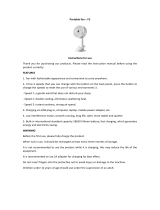
Table of contents - 3
TABLE OF CONTENTS
First things first 6
Your guides ............................................. 6
Basic care and tips for using your
computer.................................................. 6
Turning your computer off........................... 6
Taking care of your computer ..................... 7
Taking care of your AC adapter.................. 8
Cleaning and servicing................................ 8
Guidelines for safe battery usage ............... 8
Internal battery....................................... 11
Your ConceptD notebook tour 12
Screen view ........................................... 12
Keyboard view ....................................... 13
Right view ............................................. 14
USB 3.2 Gen 1 information ....................... 15
Left view ................................................ 15
USB Type-C information ........................... 15
Rear view............................................... 16
Base view .............................................. 16
Using the keyboard 18
Lock keys............................................... 18
Special keys .......................................... 18
Hotkeys.................................................. 19
Windows keys........................................ 19
EzelTM Hinge 20
Rechargeable Active Stylus 22
Fast-charging......................................... 22
Remove or insert the stylus ................... 23
Using the Precision Touchpad 24
Touchpad gestures................................ 24
Changing touchpad settings .................. 26
Recovery 28
Creating a file history backup ................ 28
Backing up your wireless and LAN
drivers.................................................... 30
Creating a factory default backup.......... 31
Restoring your computer ....................... 35
Reset this PC and keep my files ............... 35
Reset this PC and remove everything ...... 37
Using a Bluetooth connection 41
Enabling and disabling Bluetooth .......... 41
Enable Bluetooth and add a device .......... 41
Connecting to the Internet 43
Connecting to a wireless network.......... 43
Connecting to a wireless LAN................... 43
Connecting with a cable ........................ 46
Built-in network feature ............................. 46
ConceptD Palette 47
The ConceptD Palette main screen....... 47
Color profile setting ................................... 47
TrueHarmony setting ................................ 49
Monitoring .............................................. 49
Split Screen ........................................... 50
App Center............................................. 50
Advanced Settings................................. 51
Adjust ConceptD Key................................ 51
Enable PrtScn Key to launch Screen Snip
tool ............................................................ 52
Manage the copied items in Clipboard...... 53
Color Picker .............................................. 54
On-screen Keyboard Shortcuts................. 55
Set color profile on ConceptD monitor... 56
Sync up the color profile ........................... 56
Change the color profile............................ 56
Bluelight Shield 58
Securing your computer 60
Using a computer security lock.............. 60
Using passwords ................................... 60
Entering passwords .................................. 61
Fingerprint Reader 62
How to use the fingerprint reader .......... 62
BIOS utility 67
Boot sequence....................................... 67
Setting passwords ................................. 67
Power management 68
Saving power ......................................... 68
Battery pack 70
Battery characteristics ........................... 70
Charging the battery ................................. 70
Optimizing battery life ............................... 71
Checking the battery level......................... 72
Battery-low warning .................................. 72
Traveling with your computer 73
Disconnecting from the desktop ............ 73
Moving around ....................................... 73
Preparing the computer ............................ 73
What to bring to meetings ......................... 74
Taking the computer home .................... 74
Preparing the computer ............................ 74
What to take with you................................ 75
Special considerations .............................. 75
Setting up a home office ........................... 75
Traveling with the computer................... 76
Preparing the computer ............................ 76
What to take with you................................ 76
Special considerations .............................. 76
Traveling internationally......................... 76
Preparing the computer ............................ 77
What to bring with you .............................. 77
Special considerations .............................. 77




















